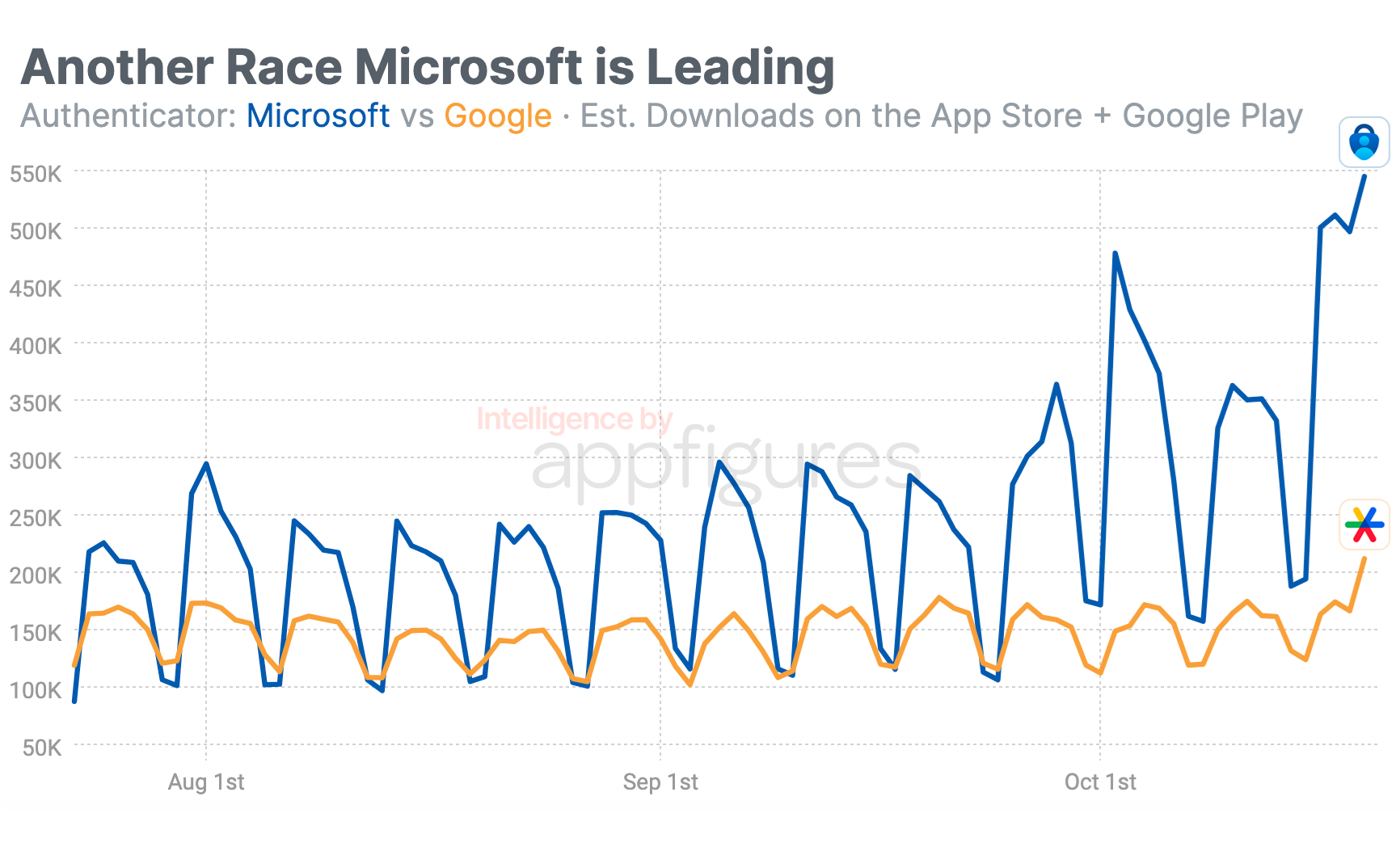In a world where cybersecurity is the name of the game, 2 Factor Authentication is our digital superhero. And what's a superhero without an authenticator app? It's like Batman without his utility belt - inconceivable!
Now, here's a question for you: How many downloads do you think authenticator apps score daily? Get ready for a jaw-dropper.
More downloads than you can shake a digital stick at!
In the dazzling world of authenticator apps, two heavyweight champions reign supreme: Microsoft and Google. Google's app, born in the digital dinosaur age of 2010, had become a bit, well, stale - like yesterday's bread. But hold on to your digital hats, because it recently got a turbocharged makeover, and now it's back in the game, ready to rumble.
Meanwhile, Microsoft, the fresher face on the scene since 2015, has been quietly turning heads. Its growth was slow and steady this summer, but just in recent weeks, it hit the afterburners.
Let's crunch some numbers: Microsoft Authenticator saw a meteoric rise, going from a respectable 1.1 million weekly downloads in July to an eye-popping 2.1 million downloads just last week. Yes, you read that right - over two million folks worldwide thought, "You know what? I need Microsoft's authenticator app in my life!"
But, hold on a second. Is this a Microsoft exclusive party, or is it a cybersecurity soirée that everyone's invited to? To get the scoop, Ariel Michaeli, the number cruncher at AppFigures, compared it to Google Authenticator. According to Michaeli's analysis, Google's downloads remained as stable as your grandma's secret chocolate chip cookie recipe, with around one million downloads from July until now.
Now, a lot of us here might have tried various authenticator apps over the years, but Microsoft's app? For a majority of us it will likely be a 'Nope', it's still the mysterious stranger in the digital neighborhood. Clearly, that's a road less traveled.
So, in a world where messaging and authenticators rule the roost, what's the next act in the ever-evolving cyber circus? Stay tuned, because the digital big top is always full of surprises!
Read next: AI and Cloud: Unmasking the New Threat Landscape of Cybersecurity
Now, here's a question for you: How many downloads do you think authenticator apps score daily? Get ready for a jaw-dropper.
More downloads than you can shake a digital stick at!
In the dazzling world of authenticator apps, two heavyweight champions reign supreme: Microsoft and Google. Google's app, born in the digital dinosaur age of 2010, had become a bit, well, stale - like yesterday's bread. But hold on to your digital hats, because it recently got a turbocharged makeover, and now it's back in the game, ready to rumble.
Meanwhile, Microsoft, the fresher face on the scene since 2015, has been quietly turning heads. Its growth was slow and steady this summer, but just in recent weeks, it hit the afterburners.
Let's crunch some numbers: Microsoft Authenticator saw a meteoric rise, going from a respectable 1.1 million weekly downloads in July to an eye-popping 2.1 million downloads just last week. Yes, you read that right - over two million folks worldwide thought, "You know what? I need Microsoft's authenticator app in my life!"
But, hold on a second. Is this a Microsoft exclusive party, or is it a cybersecurity soirée that everyone's invited to? To get the scoop, Ariel Michaeli, the number cruncher at AppFigures, compared it to Google Authenticator. According to Michaeli's analysis, Google's downloads remained as stable as your grandma's secret chocolate chip cookie recipe, with around one million downloads from July until now.
Now, a lot of us here might have tried various authenticator apps over the years, but Microsoft's app? For a majority of us it will likely be a 'Nope', it's still the mysterious stranger in the digital neighborhood. Clearly, that's a road less traveled.
So, in a world where messaging and authenticators rule the roost, what's the next act in the ever-evolving cyber circus? Stay tuned, because the digital big top is always full of surprises!
Read next: AI and Cloud: Unmasking the New Threat Landscape of Cybersecurity

